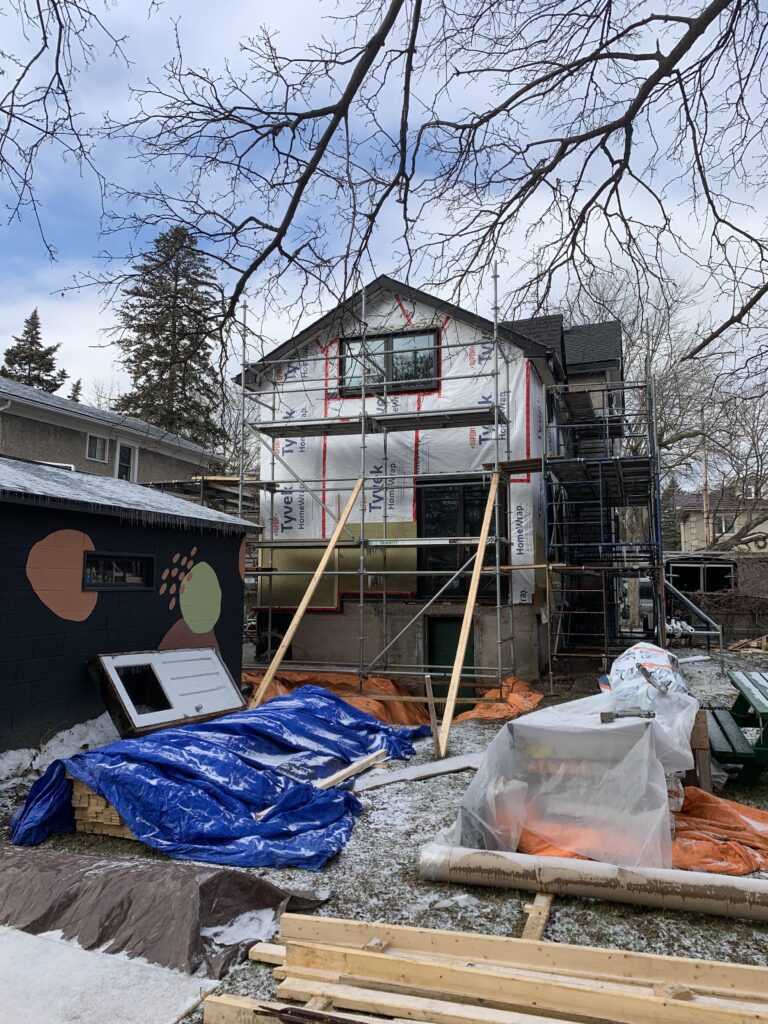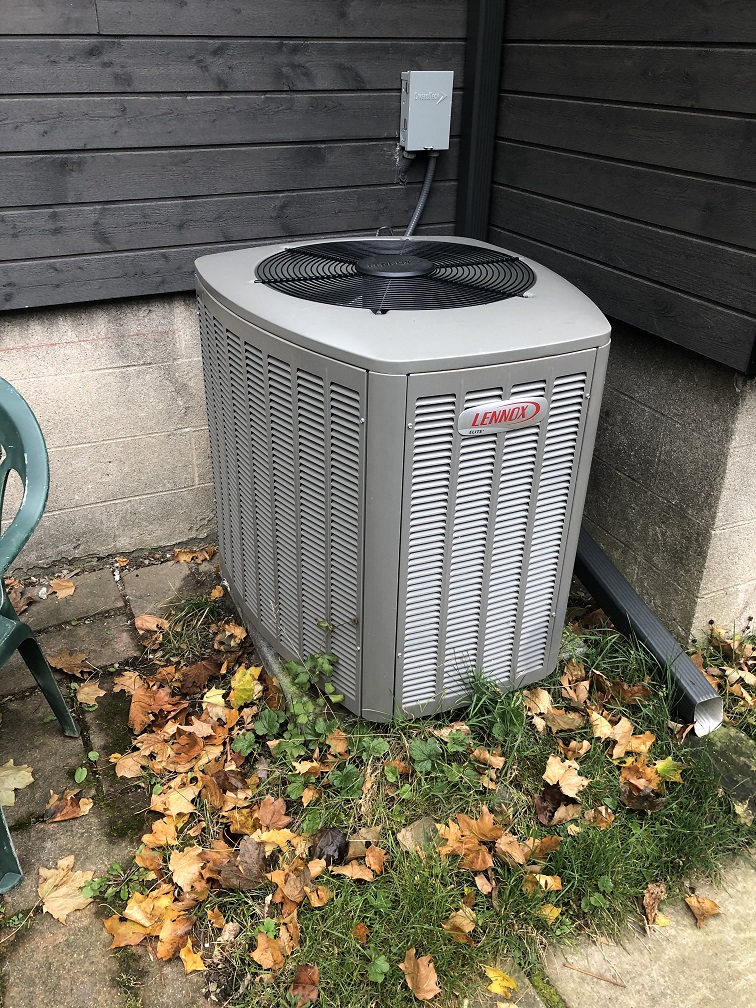Emily Hansen and Andrew Learmonth live in a two-storey, 1930s sunset-facing ~1500 ft² (~140 m²) detached house in Guelph, Ontario. This house, a short walk from old city hall, had a pebbledash stucco finish when the young couple purchased it in the Summer of 2021. The absence of insulation in their walls made itself known later that winter as ice formed on those very same walls.
To exile the indoor ice formations, banish the oppressive summer heat, and exorcise the perennial draft in the basement, Emily and Andrew decided they needed a deep energy retrofit of their house. The couple called in the services of professional discomfort busters and got to work addressing all the problem areas in the building. Hansen and Learmonth reduced their annual energy use by 80 GJ with mechanical and building envelope upgrades to their home.
| Retrofit at a Glance | |
| Starting Point | Retrofit Results |
| 157 GJ EnerGuide Rating | 77 GJ EnerGuide Rating (51% energy savings) |
| Air-leakage rate of 10.4 ACH50 | Air-leakage rate reduced 55% to 4.7 ACH50 |
| Attic insulation R12 | Attic now R60 |
| Wall insulation 84% R0 | Wall insulation to R14 and R24 |
| / | 1 door and 11 windows replaced with fibreglass-framed ENERGY STAR models |
| / | Heat loss reduced by 46% |
| 97% efficient condensing gas furnace | Added an air-source heat pump |
| Built 1930 | Retrofit 2023-2024 |
| / | GHGs down 68% |

The Home Retrofit Journey
Emily and Andrew decided that their century-old house needed to be brought into the new millennium and leave in the past its leaky old windows and the chilly, dusty drafts they let in. The couple scheduled their first EnerGuide evaluation in May 2022.
“We were looking for a local company and knew of the great work Reep Green Solutions does to raise awareness about sustainability—so we chose them,” the couple explained. “We found [Mattias, our] energy advisor [,] to be very knowledgeable, and they were able to help us navigate the sometimes-confusing Canada Greener Homes Loan process, which was much appreciated!”

Additional insulation was added before the new wood siding was installed.
In August 2022, Hansen and Learmonth installed an air-source heat pump in their home to take over the heating for the cold months, keeping their existing condensing gas furnace as a complementary system for any exceptionally cold winter nights. In November, wall insulation was installed from the interior. In some sections of these walls, Emily and Andrew installed the mineral wool batt insulation themselves to save on a portion of the labour costs, while other sections were completed by their contractors. Window and door replacements, alongside draft-proofing work, were gradually completed the following year in 2023. The new ENERGY STAR fibreglass-framed windows are high-performance, durable units. More insulation and wood siding were added to the walls from the outside later that year.

Loose-fill fibreglass insulation is loaded into a machine that conveniently blows it into place; this is a similar process for other types of blown insulation, like carbon-capturing cellulose.
From just the envelope upgrades, the homeowners saved 50 GJ of annual operating energy use and cut their home’s heat loss by nearly half.
“We knew it needed lots of work,” the homeowners declared, “but it wasn’t until we got into the renovation that we realized the extent of energy upgrades needed to make our home comfortable and enjoyable. The renovation was basically a full gut of the interior and exterior, so we knew it was the perfect time to make the kind of upgrades that would really add value, now and for the future. It needed lots of work which included aesthetic upgrades and improvements to mechanical, plumbing, and electrical systems.”
The Retrofit’s Benefits
Emily and Andrew’s house started off quite leaky and inefficient at over ten air-changes per hour. Theirs was a typical century home with little-to-no-insulation, old broken windows, and drafty inefficient doors. When all the work was done, their home was far more comfortable: warm in the winter and cool in the summer—no more water condensing onto the walls and freezing into ice!
“Insulation and windows have made a big difference,” the couple explains. “Our home is much quieter and more comfortable, so we are glad we took the time and money to properly insulate it.”

Hansen and Learmonth’s new air-source heat pump.
The young couple also gets the satisfaction and peace of mind that their energy savings also translate into greenhouse gas savings of 4.8 tonnes of carbon emissions per year. That’s like taking one fossil-fueled car off the road!
Financial and Climate Goals
Hansen and Learmonth tapped into the home energy efficiency supports made available to them by Natural Resources Canada’s Canada Greener Homes Grant and the Canada Greener Homes Loan provided by the Canada Mortgage and Housing Corporation. The young couple received the full $5,000 from the grant program, including the full $600 EnerGuide evaluation rebate, and about $26,000 from the interest-free loan program.
“We received the Greener Homes Loan and the maximum available rebate,” the couple stated. “This helped make it possible for us to take on such an extensive project. We are also currently checking our eligibility for the [Canada Revenue Agency’s GST/HST] New Housing Rebate.”

Emily and Andrew are in front of their energy-efficient home after the completion of a deep energy retrofit.
During their deep energy retrofit, Emily and Andrew encountered some trouble navigating the sometimes complex demands of retrofit incentive programs.
“We had some support from our energy advisor but navigated most of it on our own. We also found that the documentation needed to apply for the Canada Greener Homes Loan and the quotes we received didn’t always match up. We ended up having to do a lot of back and forth with different vendors to get the correct documentation needed.”
Despite a few hurdles, this couple can now look forward to many comfortable years living in their home. After this deep energy retrofit, their house is not only more durable and resilient in the face of a changing climate, but also far more energy efficient and therefore cheaper to operate. Heating and cooling the house also creates far fewer global-warming emissions. If Emily and Andrew do move to a new house, their current home will have all the love and investment paid forward to its new occupants. The current movement of deep energy retrofits is a tide that raises all boats.

Recent Comments